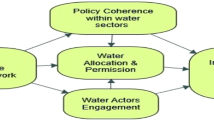Abstract
Multi-stakeholder partnerships emerged from the 2002 Johannesburg World Summit on Sustainable Development (WSSD) as a new vehicle for progressing toward the Millennium Development Goals (MDGs) by aligning the interests of businesses, governments and civil society to leverage the impact of their interventions. The water and sanitation sector boasts the largest number of such partnerships, including the demand-driven capacity-building partnership Partners for Water and Sanitation (PAWS), a product of the WSSD and a premier UK partnership for sustainable development. Through its partnership network, PAWS has access to the entire UK water industry, which they assign to capacity-building projects in Africa on a demand-driven basis. Though the supply of partners is generally strong, the demand for their assistance is variable. This paper examines the efficacy of demand-driven capacity building partnerships at achieving the water and sanitation MDGs, presenting a case study of the PAWS partnership and using it as a framework for discussion of the supply–demand dynamics that influence the scope, scale and ultimate impact of such partnerships.


Similar content being viewed by others
Notes
In 2008–2009, PAWS received £373,000, of which it allocated 27% (£97 K) to South Africa, 21% (£79 K) to Ethiopia, 20% (£75 K) to Nigeria, 16% (£61 K) to management and governance, 6% (£23 K) to fundraising, 6% to communications (£24 K) and 4% (£14 K) to Tanzania. Funds that are allocated to specific countries are for in-country staff salaries and related expenses and also for the flights and accommodations of UK partners.
References
Andonova, L. B. (2006). Globalization, agency, and Institutional Innovation: The Rise of Public-Private Partnerships in Global Governance. Goldfarb Working Paper Series, Waterville, ME, Colby College.
Andonova, L. B., & Levy, M. A. (2003). Franchising governance: Making sense of the Johannesburg type II partnerships. In O. S. Stokke & Ø. B. Thommessen (Eds.), Yearbook of international co-operation on environment and development 2003/2004 (pp. 19–31). London: Earthscan Publications.
Austin, J. E., Gutierrez, E. O. et al. (2007). Capitalizing on convergence. Stanford Social Innovation Review.
Baietti, A., & Abdel-Dayem, S. (2008). A demand-driven design for irrigation and Egypt. Gridlines. Washington: The World Bank.
Bauer, P. T. (1975). N.H. Stern on substance and method in development economics. Journal of Development Economics, 2, 387–405.
Benner, T., Streck, C., et al. (2003). Networks and partnerships in global environmental governance. Progress or Peril?. Washington: Global Public Policy Institute.
Biermann, F., & Chan, M.-s. (2007). Multi-stakeholder partnerships for sustainable development: does the promise hold? In P. Glasbergen, F. Biermann, A. P. J. Mol, et al. (Eds.), Partnerships, governance and sustainable development. Northampton, MA: Edward Elgar.
Burnside, C., & Dollar, D. (2004). Aid, policies, and growth: revisiting the evidence. Policy Research Working Paper Series. Washington, DC, World Bank.
Cohen, W. M., & Levinthal, D. A. (1990). Absorptive capacity: A new perspective on learning and innovation. Administrative Science Quarterly, 35(1), 24.
Easterly, W. (2003). Can foreign aid buy growth? Journal of Economic Perspective, 17, 23–48.
ECO-Equity. (2002). Critical considerations about Type 2 partnerships. World summit on sustainable development. Johannesburg: ECO-Equity.
Friedman, M., & Friedman, R. (1982). Capitalism and freedom. Chicago: University of Chicago Press.
Glasbergen, P. (2007). Setting the scene: The partnership paradigm in the making. In P. Glasbergen, F. Biermann, & A. P. J. Mol (Eds.), Partnerships, governance and sustainable development: Reflections on theory and practice (p. 328). Northampton, MA: Edward Elgar Publishing Limited.
Gleick, P. (2006). Key trends in PPPs and drivers for change in the future. Paris: OECD Global Forum on Sustainable Development.
Hale, T. N., & Mauzerall, D. L. (2004). Thinking globally and acting locally: Can the Johannesburg partnerships coordinate action on sustainable development? Journal of Environment & Development, 13(3), 19.
Hall, D., Lobina, E., et al. (2005). Public resistance to privatisation in water and energy. Development in Practice, 15(3), 15.
Levinger, B. (2002). Togetherness: How governments, corporations and NGOs partner to support sustainable development in Latin America. Arlington, VA: Inter-American Foundation.
Miraftab, F. (2004). Public–private partnerships: The Trojan horse of neoliberal development? Journal of Planning Education and Research, 24(1), 12.
PAWS (2002). Annual Report 2001–2002, Partners for Water and Sanitation.
PAWS (2006). Annual Report 2005–2006, Parnters for Water and Sanitation.
PAWS (2007). Annual Report 2006–2007, Partners for Water and Sanitation.
PAWS (2008). Annual Report 2007–2008, Partners for Water and Sanitation.
PAWS (2009). Annual Report 2008–2009, Partners for Water and Sanitation.
Sachs, J. (2005). The end of poverty: Economic possibilities for our time. New York: Penguin Press.
Stewart, A., & Gray, T. S. (2009). The Governance of Water and Sanitation in Africa. London: Tauris Academic Studies.
UN. (1992). Agenda 21 (p. 350). Rio de Janerio: United Nations.
UN (2009). CSD partnerships database. Retrieved 1 November, 2009, from http://webapps01.un.org/dsd/partnerships/public/statisticsResults.do.
WEF. (2005). Development-driven public-private partnerships in water. Financing for development initiative (p. 10). Geneva: World Economic Forum.
Wolff, G., & Hallstein, E. (2005). Beyond privatization: Restructuring water systems to improve performance. Oakland: The Pacific Institute for Studies in Development, Environment and Security.
World Bank (2009). Poverty and social impact analysis—Glossary. Retrieved 12 Nov 2009, from http://go.worldbank.org/7BKU4R5560.
World Water Assessment Programme (2009). The United Nations World Water Development Report 3: Water in a Changing World. Paris.
WWF (2009). 5th World Water Forum Final Report. Istanbul, World Water Forum: 190.
Acknowledgments
This article grew out of research conducted for a course titled “Public–Private Partnerships for Sustainable Development” taught by Dr. Lyuba Zarsky at the Monterey Institute of International Studies. Amer Barghouth provided extraordinary assistance during the initial stages of research that contributed significantly to this article. Our many thanks to both Dr. Zarsky and Mr. Barghouth as well as the PAWS staff who facilitated this research, particularly Ms. Clare Twelvetrees.
Author information
Authors and Affiliations
Corresponding author
Additional information
Readers should send their comments on this paper to BhaskarNath@aol.com within 3-months of publication of this issue.
Rights and permissions
About this article
Cite this article
Wertz, B.A., Odekova, A. & Seaman, M. Building capacity with demand-driven partnerships: a case study of Partners for Water and Sanitation. Environ Dev Sustain 13, 19–33 (2011). https://doi.org/10.1007/s10668-010-9245-9
Received:
Accepted:
Published:
Issue Date:
DOI: https://doi.org/10.1007/s10668-010-9245-9




